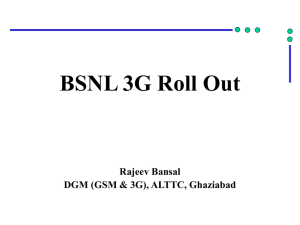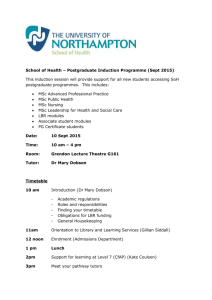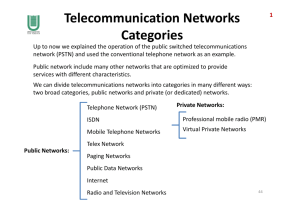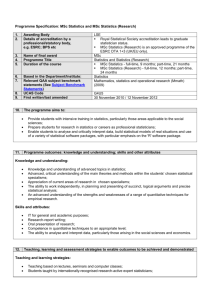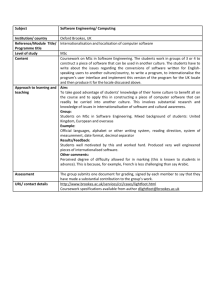Lecture_5-CTTC_20120408
advertisement
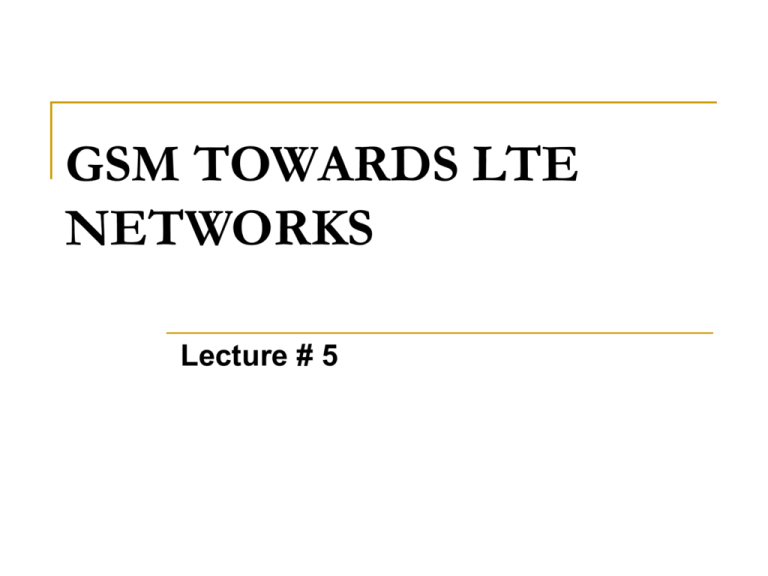
GSM TOWARDS LTE NETWORKS Lecture # 5 MOBILE TRAFFIC VOICE AND DATA 07-14 Subscriber traffic in mobile access networks 30 Yearly Exabytes 25 Exabyte = Giga Giga Byte 20 Data 15 10 Voice 5 0 2007 2008 2009 2010 Source: Internal Ericsson DVB-H, Mobile WiMax, M2M and WiFi traffic not included This slide contains forward looking statements 2011 2012 2013 2014 THE 3G VISION Global Seamless Roaming Common Worldwide Spectrum Multiple Radio Environments Wide Range of Services -Voice & Data Equally Flexible, Spectrum Efficient Technologies Wireless - Wireline Integration Enhanced Security and Performance Wireline Services and Quality Levels Rapid Introduction of New Technology 3G VISION - APPLICATION Application Multimedia Message Service (MMS) Email Video phone Video streaming Any service from the Internet 3G VAS APPLICATIONS Video SMS Video Portal Mobile TV Video IVR Video CRBT Mobile Video Marketing YouTube upload Video conferencing Video greeting Dial TV service 3G Music Station with full track song download Video Contact Center 2G TOWARDS 3G Higher data bandwidth requirement Anticipated subscriber demand for Audio/Video streaming Other multimedia services Collaborative services Location services 3G - PRINCIPLE REQUIREMENT Support for voice quality comparable with fixed line networks Support for both circuit-switched and packet-switched data services Support for greater capacity and improved spectrum efficiency 3G–PRINCIPAL REQUIREMENT A data rate of 144 kb/s for users moving quickly e.g. moving vehicles A data rate of 384 kb/s for pedestrians A data rate of 2 Mb/s in a low mobility or office environment. Note how a network using GPRS and EDGE meets most of these criteria! Example: 3G SERVICES (UMTS) Universal Mobile Telephone System (UMTS) Four QoS classes of services Conversational Class Streaming Class multimedia, video on demand, webcast Interactive Class Voice, video telephony,video gaming WWW browsing, database access, online gaming Background Class email, SMS, file downloading 2.5 GPRS VOICE / data ARCHITECTURE Voice Calls Path Data Calls Path Packet Data14.4 Kp/s LTE/SAE Architecture 3G NETWORK IP networks Only PS Domain shown Gi HLR/HSS Gr Gn Gn GGSN SGSN Gb Iu BSC RNC BTS Node B 2G 3G Iur LTE/SAE Architecture HSPA (High Speed Packet Access) IP networks Only PS Domain shown Gi HLR/HSS PCRF Gr Gx Gn GGSN SGSN Gb Iu CP Iu UP BSC RNC BTS Node B 2G Optimizing the 3G/HSPA payload plane for Broadband traffic Iur 3G Release 7 ”Direct Tunnel” STEPS TOWARDS 3G 1- Backbone Roll Out (Packet Network) All the backend traffic transfer on IP (Packets) /Passport/ATM/MPBN 2- Data Network 3- Core Network 4- RAN Network 1-BACKBONE ROLL OUT (Packet Network) Migration Steps 2-DATA NETWORK MIGRATION 2nd GENERATION NETWORK rd 3 GENERATION NETWORK 2G & 3G NETWORK TOWARDS IP NETWORK 3-CORE NETWORK MIGRATION Classical MSC Architecture (old name: Non-Layered Mobile Core Network/ ’Monolitic’ Architecture) MSC Server Classic MSC MSC Mobile Softswitch Solution (old name: Layered Mobile Core Network Architecture) (Control and Switching) MSC-S (Control) Mobile Media Gateway MGw (Switching) Control Layer MSC-S MSC MGw MSC MSC TDM MSC MSC MGw IP/ATM/TDM MGw MGw MGw INCREMENTAL MIGRATION In Pakistan, Most operators have incrementally Migrated. Two strategies have been adapted GPRS adapted by Warid Telecom. EDGE adapted by Ufone. MOBILE SOFT SWITCH SOLUTION FOR 3G CORE NETWORK One of the most efficient way to upgrade for 3G core networks. Layered MSS architecture for ease is only for Mobile core networks LAYERED ARCHITECTURE The benefit of layered architecture is from research and development purpose. In communication there are two main recourses i.e. controlling and connectivity. MSS LAYERS 1. Control Layer 2. Connectivity Laye 3. Application Layer CONTROL LAYER This layer is refer to the logical layer as it performs logical operations of the MSS this node provides the analysis and control functions required for circuit switched traffic and using standardized signaling controlling the allocation of resources in the connectivity layer required CONNECTIVITY LAYER This layer is based on ATM (Asynchronous Transfer Mode) and IP protocols. Providing end-to-end connection throughout the core network. This layer provide standard interfaces for the connectivity with other legace networks. APPLICATION LAYER In this layer all the application are added and managed. Like if Warid want to provide CBRT (Caller Back Ring Tone) service then it add server that provide this service to the user in the application layer. Recourses of such servers are controlled by MSC-S. MSS ARCHITECTURE MSS NODES 1. MSC-S (Mobile Switching Server) 2. M-MGW (Mobile Media Gateway) MSC-SERVER MSC-S is the control layer device of the 3G network. It contains all call and control service logic such as: ѣ Charging analysis ѣ Bearer selection ѣ Route analysis ѣ Media Gate way selection MSC-SERVER It provides efficient and centralized control of the distributed switching provided by the Mobile Media Gateway (M-MGw), ensuring flexible, cost-effective network design, and a smooth evolution to an all-IP core network. MSC-SERVER Data Base nodes Radio Sites Other MSC-S MSC-S M-MGW M-MGW M-MGW is the connectivity layer device. M-MGW connects the MSS core network with the external networks such as WCDMA and GSM radio access networks, PSTN networks, PABXs, IMS/VoIP network, or other mobile networks. This node controlled by MSC-S. SIGNALING AND PROTOCOLS MAP BSC BSSAP MSC Server 1 Data Base Nodes BICC / MAP MAP T-MSC Server 1 RANAP GCP GCP RNC M-MGW 1 M-MGW 2 ISUP SIP PSTN/ISDN/PL MN INTERFACE & PROTOCOLS MSC Server 1 BSC A RNC Lu CS Nc Mc M-MGW 1 T-MSC Server 1 Mc Nb PSTN/ISDN/PLMN M-MGW 2 Control Plane User Plane POI 3G CALL SETUP Call Setup Scenario : Subscriber “A” is a calling party from PTML and Subscriber “B” is called party that is related to PSTN MSC Server 1 T-MSC Server 1 PSTN/ISDN/PLM N RNC M-MGW 1 M-MGW 2 IP BS 1. SETUP MSC Server 1 T-MSC Server 1 PSTN/ISDN/PLM N RNC M-MGW 1 M-MGW 2 IP BS 2. RNC send SETUP message to MSC-S MSC Server 1 T-MSC Server 1 PSTN/ISDN/PLM N RNC M-MGW 1 M-MGW 2 IP BS 3. SEIZE RESOURCES MSC Server 1 T-MSC Server 1 PSTN/ISDN/PLM N RNC M-MGW 1 M-MGW 2 IP BS 4. M-MGW reply by ACK message MSC Server 1 T-MSC Server 1 PSTN/ISDN/PLM N RNC M-MGW 1 M-MGW 2 IP BS 5. MSC-S inform RNC that call is in progress by CALL PROCESSED message MSC Server 1 T-MSC Server 1 PSTN/ISDN/PLM N RNC M-MGW 1 M-MGW 2 IP BS 6. MSC-S send ASSIGNMENT message MSC Server 1 T-MSC Server 1 PSTN/ISDN/PLM N RNC M-MGW 1 M-MGW 2 IP BS 7. RNC send ERQ message to selected M-MGW MSC Server 1 T-MSC Server 1 PSTN/ISDN/PLM N RNC M-MGW 1 M-MGW 2 IP BS 8. M-MGW setup virtual connection with RNC and reply by ECF message MSC Server 1 T-MSC Server 1 PSTN/ISDN/PLM N RNC M-MGW 1 M-MGW 2 IP BS 9. RNC send ASSIGNMENT COMPLETE message MSC Server 1 T-MSC Server 1 PSTN/ISDN/PLM N RNC M-MGW 1 M-MGW 2 IP BS 10.MSC-S 1 send IAM message to MSC-S 2 MSC Server 1 T-MSC Server 1 PSTN/ISDN/PLM N RNC M-MGW 1 M-MGW 2 IP BS 11.T-Server send SEIZE RESOURCE message to selected M-MGW MSC Server 1 T-MSC Server 1 PSTN/ISDN/PLM N RNC M-MGW 1 M-MGW 2 IP BS 12. M-MGW send reply by ACK MSC Server 1 T-MSC Server 1 PSTN/ISDN/PLM N RNC M-MGW 1 M-MGW 2 IP BS 13. T-Server forward IAM to terminating end i.e. PSTN MSC Server 1 T-MSC Server 1 PSTN/ISDN/PLM N RNC M-MGW 1 M-MGW 2 IP BS 14. PSTN reply by ACM MSC Server 1 T-MSC Server 1 PSTN/ISDN/PLM N RNC M-MGW 1 M-MGW 2 IP BS 15. T-Server forward ACM to MSC-S MSC Server 1 T-MSC Server 1 PSTN/ISDN/PLM N RNC M-MGW 1 M-MGW 2 IP BS 16. MSC-S order M-MGW to through connection back to party “A” MSC Server 1 T-MSC Server 1 PSTN/ISDN/PLM N RNC M-MGW 1 M-MGW 2 IP BS 17. MSC-S alert party “A” by sending ring back tone and party “B” by ring tone MSC Server 1 T-MSC Server 1 PSTN/ISDN/PLM N RNC M-MGW 1 M-MGW 2 IP BS 18. As “B” party answer the call and send ANM to T-Server MSC Server 1 T-MSC Server 1 PSTN/ISDN/PLM N RNC M-MGW 1 M-MGW 2 IP BS 19. T-Server inform ANM to MSC-S MSC Server 1 T-MSC Server 1 PSTN/ISDN/PLM N RNC M-MGW 1 M-MGW 2 IP BS 20. MSC-S order to through both way speech path MSC Server 1 T-MSC Server 1 PSTN/ISDN/PLM N RNC M-MGW 1 M-MGW 2 IP BS 21. MSC-S order to RNC to connect call to traffic channel by CONNECT message MSC Server 1 T-MSC Server 1 PSTN/ISDN/PLM N RNC M-MGW 1 M-MGW 2 IP BS 22. RNC send ACK MSC Server 1 T-MSC Server 1 PSTN/ISDN/PLM N RNC M-MGW 1 M-MGW 2 IP BS 23. The UMTS call path has been established GSM Toward LTE Networks LTE/SAE Architecture LTE/SAE Architecture Product dimension PA/DU Core & IMS IP networks SGi HLR/HSS HLR/HSS ”HLR/HSS” Gr PCRF PCRF S6a S7 EPC S4 SGSN SGSN S3 MME MME S11 ”Mobility Server”S10 Gb Iu CP PDN GW PDN GW Serving GW Serving GW ”Gateway” Iu UP S1-MME BSC RNC Iur S1-U RBS eNodeBB eNode BTS 2G S2a/b PA/DU Radio X2 Node B 3G LTE OSS Non-3GPP access Lecture link www.lte.yolasite.com

